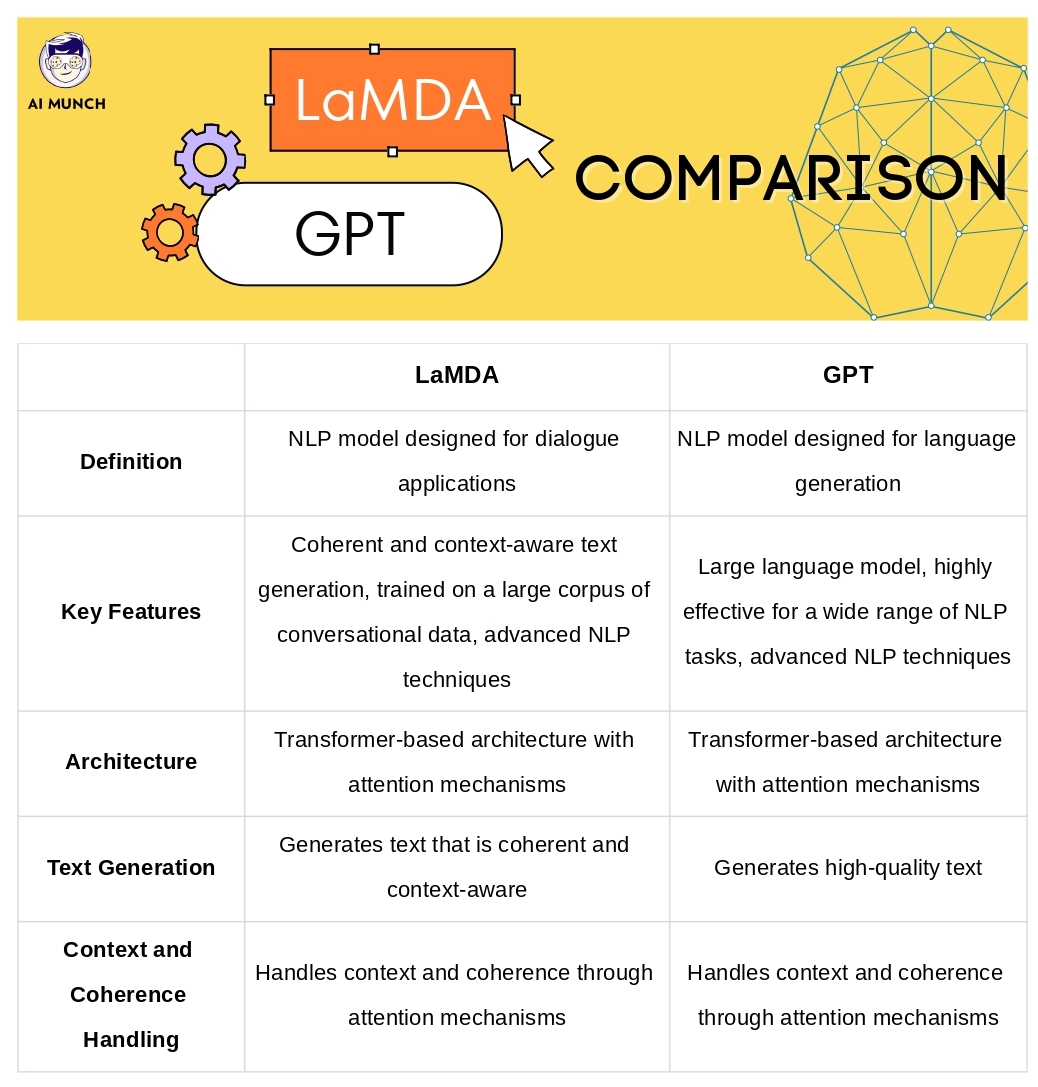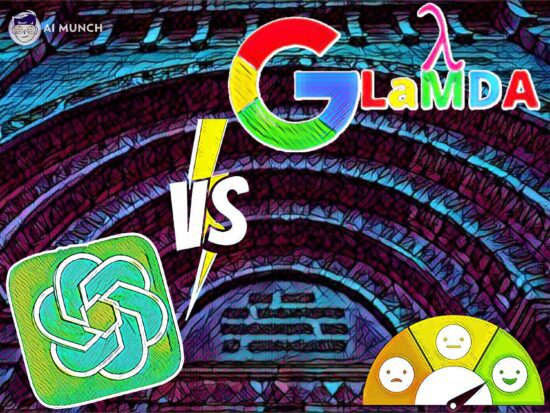I. Introduction
Google LaMDA is the finest option if you need a conversational chatbot for customer service settings. If you require an AI chatbot for a question-and-answer platform or research purposes, OpenAI GPT may be a better solution, chatGPT for example. LaMDA vs GPT is trending these days. Let’s see which one is better.
A. Explanation of LaMDA
“LaMDA” is not a very familiar term. Google AI’s LaMDA (Language Model for Dialogue Applications) is an innovative Natural Language Processing (NLP) model. LaMDA is designed to generate text in response to a prompt and has been trained on a vast corpus of web material. LaMDA can generate logical and context-aware text, making it a potent tool for dialogue systems and chatbots applications.
B. Explanation of GPT
OpenAI created GPT (Generative Pretrained Transformer), a transformer-based NLP model. GPT is capable of generating text that is logical, context-aware, and semantically relevant. it was trained on a vast corpus of text data. GPT is extensively employed for various NLP applications, including text generation, text summarization, and question answering.
C. Purpose of article
The purpose of this article is to explain:
- LaMDA and how it works, and to compare LaMDA with GPT.
- Highlighting the similarities and differences between the two models.
- An in-depth analysis of both LaMDA and GPT.
An AI arms race shouldn’t further be fueled by media. Google has invented transformers, developed LaMDA and Sparrow a long time before ChatGPT.
— David (@LandupDavid) January 22, 2023
These models were not public for a reason. Those same reasons stand today.
It’s also plain wrong to think Google is surprised by LLMs. pic.twitter.com/VpnCfZnlBJ
II. What is LaMDA
A. Definition and Explanation of LaMDA
Google AI has created a cutting-edge NLP model called LaMDA (Language Model for Dialogue Applications). By design, LaMDA produces consistent and sensitive language to its environment, making it a valuable resource in many scenarios. LaMDA employs cutting-edge developments in NLP research to generate writing that is semantically meaningful and natural-sounding; it has been trained on a vast corpus of conversational text.
B. Key Features of LaMDA
Coherent and context-aware text generation: LaMDA can make text that makes sense and sounds natural by taking into account the context of the conversation or prompt.
A large corpus of conversational text: LaMDA was trained on a large corpus of conversational text, which lets it produce text that sounds like a conversation and makes sense.
Advanced NLP techniques: To make high-quality text, LaMDA uses the latest research in NLP, such as transformer-based architectures and large-scale language models.
C. Applications of LaMDA
Question answering: LaMDA from Google can also be used to answer questions in a conversational context, making it a powerful tool for customer service and support applications.
Dialogue systems and chatbots: LaMDA is well-suited for use in dialogue systems and chatbots, where it can generate natural-sounding and coherent text in response to a prompt.
Conversational AI: LaMDA can be used to develop advanced conversational AI systems, such as virtual assistants and customer service chatbots.
Text generation: LaMDA can also be used for text generation tasks, such as content creation, fiction writing, and more.
Other NLP tasks: LaMDA can be used for a wide range of NLP tasks, such as text summarization, text classification, and more.
III. How LaMDA Works
A. Explanation of the Architecture of LaMDA
LaMDA from Google is based on a transformer-based design, which is a cutting-edge NLP architecture that has demonstrated amazing effectiveness in numerous NLP tasks. LaMDA’s architecture is comprised of a number of transformer blocks linked by a system of attention processes. These attentive mechanisms allow LaMDA to understand the context of the prompt and generate coherent and context-aware text.
B. Discussion of How LaMDA Generates Text
The foundation of LaMDA is a transformer-based architecture, which is currently considered the gold standard in NLP architecture due to its impressive performance across a wide range of NLP tasks. LaMDA’s architecture comprises individual “transformer blocks” linked together by a chain of “attention mechanisms.” As a result of these attention mechanisms, LaMDA can understand the context of the question and return answers that make sense.
C. Explanation of How LaMDA Handles Context and Coherence
LaMDA from Google handles context and consistency, utilising the architecture’s attention mechanisms. These attention mechanisms enable LaMDA to zero down on particular portions of the prompt and generate writing that is semantically relevant and sounds natural. LaMDA’s attention techniques will allow it to capture the context of the prompt and generate text consistent with the prompt and the overall dialogue. This enables LaMDA to develop context-aware and linguistically significant text, making it a potent tool for various NLP tasks.
LaMDA is a Transformer-based neural network that is trained on dialogue which gives it the ability to produce sensible and specific responses to questions. pic.twitter.com/XoN5lynJKB
— Marco Franzon (@mfranz_on) January 31, 2023
IV. Comparison with GPT
A. Explanation of GPT
GPT’s superior performance has been shown in many natural language processing (NLP) tasks, such as text generation, question answering, and others. OpenAI’s GPT is a cutting-edge natural language processing model. Using the most recent findings in NLP research, GPT is a significant language model trained on a large corpus of text to produce high-quality output.
B. LaMDA vs GPT: A Comparison

C. Advantages and Disadvantages of both models
Pros of LaMDA:
- Specifically designed for dialogue applications. LaMDA is highly effective for dialogue systems and chatbots.
- It generates coherent and context-aware text, making it a powerful tool for NLP tasks requiring coherence and context.
- It has been trained on a large corpus of conversational data, enabling it to generate text that is conversational and semantically meaningful.
Pros of GPT:
- Powerful natural language processing (NLP) capabilities thanks to a large language model.
- Extremely helpful for any effort requiring text generation, such as article writing, story writing, and more.
- It is an effective tool for natural language processing (NLP) tasks because it employs state-of-the-art NLP methods like transformer-based architectures and large-scale language models.
Cons of LaMDA:
- Currently less widely used than GPT, which may limit its availability for certain applications
- May not be as effective for NLP tasks that do not require context and coherence, such as text classification
Cons of GPT:
- Not specifically designed for dialogue applications, which may limit its effectiveness for specific NLP tasks
- It may not generate as readable text and context-aware as LaMDA, limiting its effectiveness for NLP tasks requiring context and coherence.
V. Conclusion
A. Summary of Main Points
The state-of-the-art natural language processing (NLP) models LaMDA and GPT from OpenAI were discussed here. While GPT is an extensive language model effective for various NLP tasks, LaMDA is a specialized NLP model built for dialogue applications. We analyzed the two models, contrasting their most distinguishing characteristics, architecture, text generation abilities, and context and coherence management.
B. Final Thoughts on LaMDA and GPT
This article talked about the LaMDA and GPT natural language processing (NLP) models from OpenAI, which are currently the best available. LaMDA is an NLP model explicitly developed for dialogue applications, while GPT is a comprehensive language model useful for a wide range of NLP tasks. To determine their fundamental differences, we compared the two models by looking at their architecture, text generation capabilities, and context and coherence management.
C. Future Direction for NLP Research
LaMDA and GPT only scratch the surface of what can be achieved with NLP models, so the future of NLP research is bright. More sophisticated NLP models are on the horizon, and they will be able to produce text that is meaningful and aware of context, and highly effective across a broader range of NLP tasks. Improving NLP models will significantly impact the future of human-computer interaction.
FAQs
No, Google LaMDA is not open source.
This is subject to interpretation and depends on one’s concept of “true AI.” LaMDA is a complex NLP model that can make text that sounds like a person wrote it but doesn’t have consciousness or self-awareness.
No, Google’s LaMDA is not sentient. It is an advanced NLP model capable of generating human-like writing but lacks consciousness.
It depends on whether Google has made the model publicly accessible. Google has not, to my knowledge, formally announced a natural language processing (NLP) model dubbed “Google LaMDA” as of 2021.
No, Google has not created a sentient AI. But they have developed advanced NLP models, they do not have consciousness or self-awareness.
This is up to how you look at it and what power are you talking about. Right now, OpenAI’s GPT-3 and Google’s BERT are two of the most advanced NLP models.
To some extent, this is up for debate and may evolve as more advanced Ai models are created. OpenAI’s GPT-3 and Google’s BERT are two of the most sophisticated natural language processing models available today.
Of course, this is about LaMDA vs GPT. This is a question of opinion and may evolve when new AI models are created. OpenAI’s GPT-3 and Google’s LaMDA are presently two of the most advanced NLP models for dialogue.











6 comments